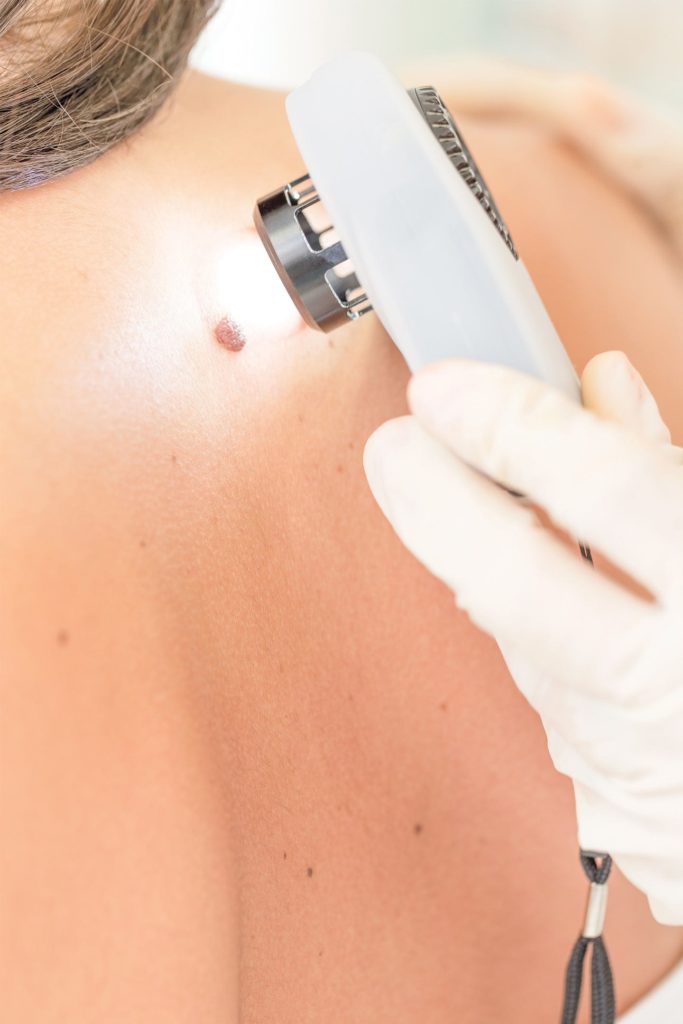Did you know that catching a melanoma in its earliest stage coincides with a 98% five-year survival rate? By stage III-IV, that drops to 65% or less. Catching skin cancer early is key to ensuring quick and effective treatment. And it’s easy! By performing skin checks at home and visiting your dermatologist regularly for routine skin exams, you can investigate and care for any suspicious lesions as they arise.
Considering 20% of Americans will have a bout with skin cancer by the time they’re 70, we think it’s worth knowing the ins and outs of this common yet scary diagnosis. So, we asked area experts to share the details on why skin checks are important, how often you should visit your dermatologist, and what you can expect.
By Lucy Morris
The 411 on Skin Cancer


Skin cancer affects all skin types and all ages – in fact, nonmelanoma skin cancer rates are on the rise in teenagers. If you spend any amount of time in the sun (or UV tanning beds!), you’re putting yourself at risk. Dr. Deanna Brown, a dermatologist with Susong Dermatology, explains the three types of skin cancer:
“Basal cell carcinoma (BCC) is the most common type of skin cancer. It can look like a pearly pimple that won’t go away or a sore spot that won’t heal. BCC is usually slow-growing and rarely spreads to other areas of the body, but it can be very destructive (growing into muscle and other deep tissue) if untreated.
Squamous cell carcinoma (SCC) is the second most common type of skin cancer and has a slightly higher risk of spreading than BCC. SCC can look like a red scaly patch or a tender, crusty, volcano-like nodule that grows quickly.
Melanoma is the third most common type of skin cancer, and it is much more dangerous than BCC and SCC. Melanomas usually are black, dark brown, or multicolored and can appear on their own or evolve from a pre-existing mole. Melanomas can quickly spread to lymph nodes and other organs in the body and can even come back years after they are excised.”
Unfortunately, skin cancer tends to grow silently and without symptoms in its early stages, so knowing if you’re at an increased risk is important.
 Risk Factors & Prevention Methods
Risk Factors & Prevention Methods
While skin cancer can affect anyone, certain factors place you at higher risk. Dr. John Chung, a dermatologist with Skin Cancer & Cosmetic Dermatology Center, explains, “A history of tanning, history of sunburns, blonde or red hair, light eye color, skin that freckles or sunburns easily, family history of melanoma, irregular moles, and having more than 50 moles all place a person at higher risk for skin cancer.” Those with suppressed immune systems, whether from medications or medical conditions, are also at an increased risk.
The good news is that most skin cancers are preventable. To protect yourself, especially if that list of risk factors looks all too familiar, you should always make sure to wear sunscreen (even in the colder months and on cloudy days!), wear protective clothing like wide-brimmed hats and sunglasses, pay attention to any medications that might cause your skin to be more sensitive to the sun, avoid the sun during the middle of the day when possible, and check your skin regularly at home.
At-Home Skin Checks
Checking your skin at home regularly is important because you know your skin best and can recognize changes. You should look for lesions that bleed, itch, hurt, or scab, while also making note of any new or unusual spots. Dermatologists also recommend looking for the ABCDEs of melanoma:
Asymmetry: If you draw a line through this mole, the two halves will not match.
Border: The borders of the mole are irregular, scalloped, or poorly defined.
Color: Colors throughout the mole vary and can include different shades of tan, brown, or black, or there may be areas of red, white, or blue.
Diameter: Melanomas are usually larger in diameter than the size of a pencil eraser, though they may sometimes be smaller when
first detected.
Evolving: Any change – in size, shape,
color, elevation, or another trait, or any new symptom such as bleeding, itching, or crusting – points to danger.
If you notice any of the above symptoms – or if something just causes you to feel uneasy – you should visit your dermatologist for further evaluation. You should also be visiting your dermatologist at least once a year – or more if you’re at higher risk – for professional skin exams. “If you have risk factors that make you more susceptible to skin cancer, you should start getting yearly skin exams by your early 20s,” says Dr. Brown. “If you do not have risk factors, I suggest a baseline skin exam by age 30, then continued follow up as directed by your dermatologist.”


Professional Skin Exams


Dermatologist,
Susong Dermatology
Professional skin exams are quick, easy, and painless. If you haven’t had one before, Dr. Chung explains what you can expect. “You’ll be asked to remove your clothes and put on a medical gown. Your provider will check you thoroughly from head to toe, paying close attention to hard-to-see spots like your scalp, back, ears, and even between your toes.”
To prep, it’s recommended you wear easy-to-remove clothing and footwear and that you remove any makeup and nail polish prior to the appointment. You should also wear your hair loose, so checking the scalp is easy.
“Your dermatologist will also ask you about your personal and family history of skin cancer and may suggest a biopsy (skin sampling) or cryotherapy (freezing with liquid nitrogen) of suspicious lesions at the end of the visit,” says Dr. Brown.
Treating Skin Cancer
If it turns out you have a cancerous lesion, all hope is not lost! There are numerous methods of treatment that can help. Dr. Chung explains, “Mohs surgery is the ‘gold standard’ and most effective technique for treating many BCCs, SCCs, and melanomas. It has the highest cure rate while sparing healthy tissue and leaving the smallest possible scar. Plus, it is done in a single visit using local anesthesia. In some cases, other treatments may be considered, such as excision, electrodessication and curettage (which is a scraping or burning off of skin growths), or superficial radiation therapy. Sometimes, special creams or oral medications may be used to treat skin cancers.”

